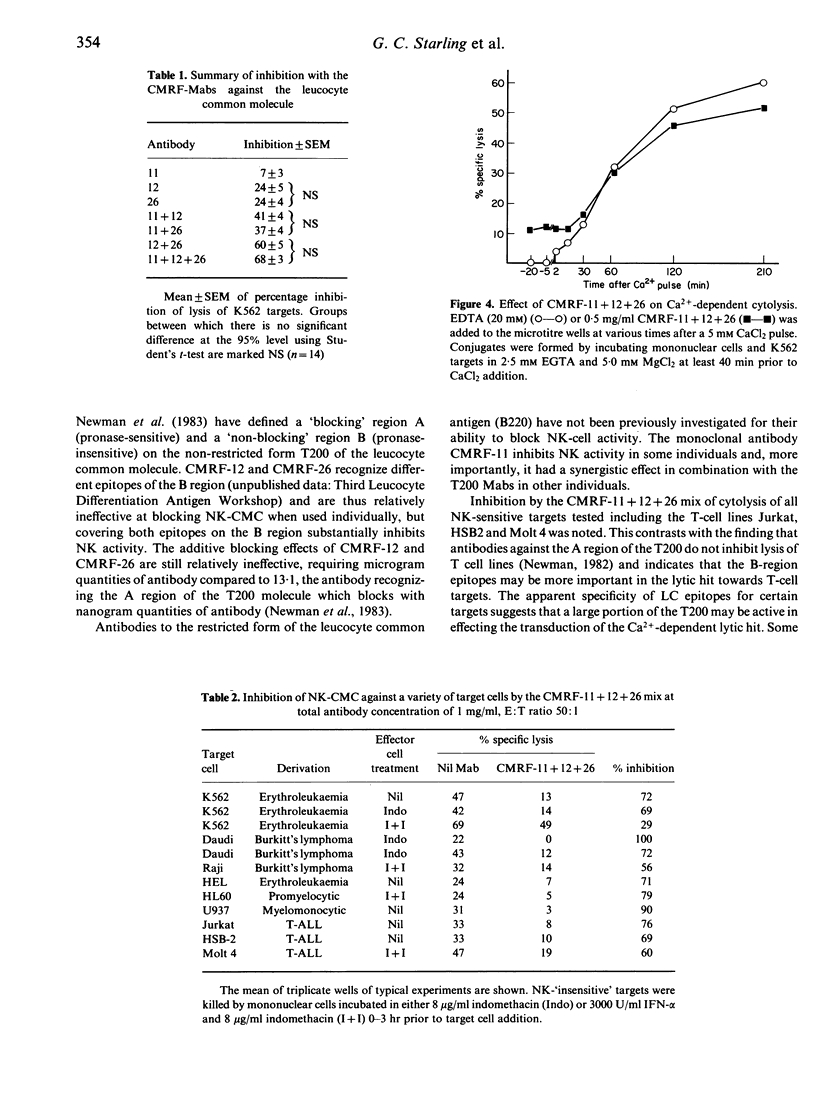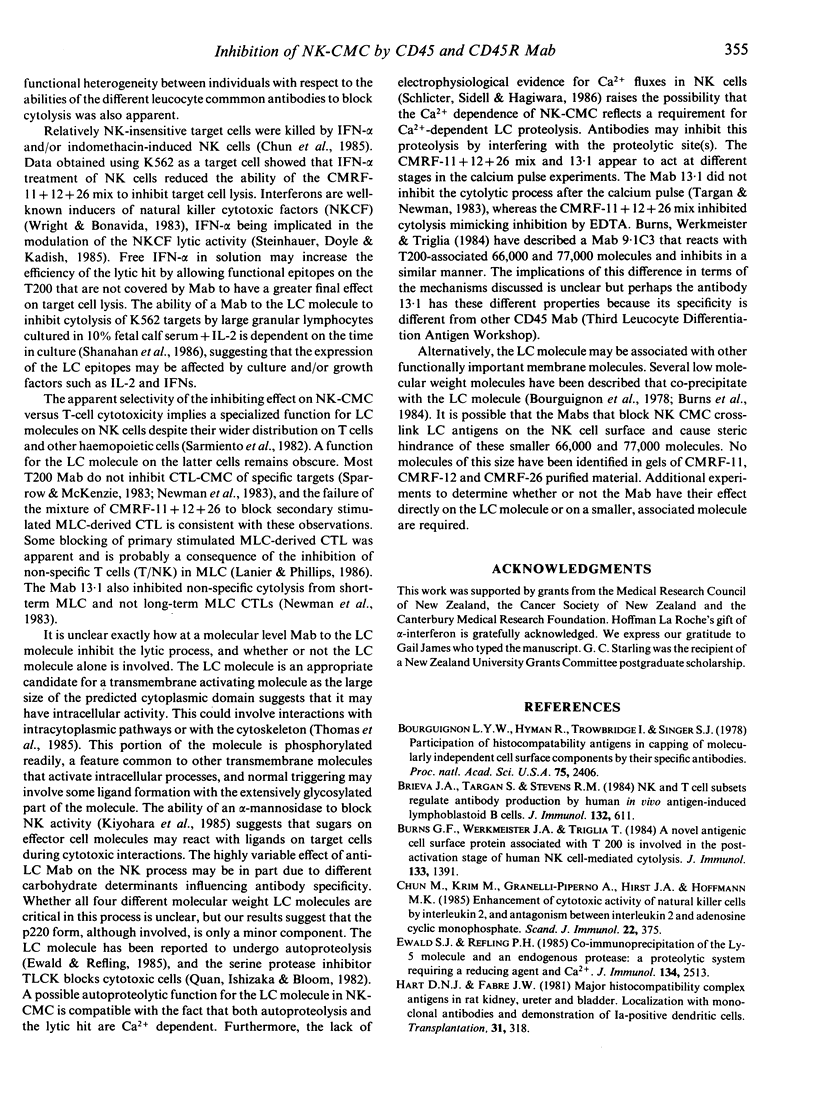Abstract
Three monoclonal antibodies recognizing different epitopes of the leucocyte common molecule, CMRF-11 (against the restricted or B-220 leucocyte common molecule), CMRF-12 and CMRF-26 [each against a different epitope on the non-restricted or T200 leucocyte common (CD45) molecule], were tested for their effects on lymphocyte cytotoxicity. The individual monoclonal antibodies inhibited human natural killer cell-mediated cytolysis (NK-CMC) weakly, but a mixture of CMRF-11 + 12 + 26 antibodies inhibited cytolysis more consistently and to a greater extent. This mixture did not inhibit cytotoxic T lymphocytes derived from secondary mixed lymphocyte cultures. The CMRF-11 + 12 + 26 mix was shown to inhibit a post-conjugate formation stage of lysis at the effector cell level. Inhibition of NK-CMC of a wide range of target cells, including the T-cell lines Jurkat, HSB2 and Molt 4, was demonstrated.
Full text
PDF





Selected References
These references are in PubMed. This may not be the complete list of references from this article.
- Bourguignon L. Y., Hyman R., Trowbridge I., Singer S. J. Participation of histocompatibility antigens in capping of molecularly independent cell surface components by their specific antibodies. Proc Natl Acad Sci U S A. 1978 May;75(5):2406–2410. doi: 10.1073/pnas.75.5.2406. [DOI] [PMC free article] [PubMed] [Google Scholar]
- Brieva J. A., Targan S., Stevens R. H. NK and T cell subsets regulate antibody production by human in vivo antigen-induced lymphoblastoid B cells. J Immunol. 1984 Feb;132(2):611–615. [PubMed] [Google Scholar]
- Burns G. F., Werkmeister J. A., Triglia T. A novel antigenic cell surface protein associated with T200 is involved in the post-activation stage of human NK cell-mediated lysis. J Immunol. 1984 Sep;133(3):1391–1396. [PubMed] [Google Scholar]
- Chun M., Krim M., Granelli-Piperno A., Hirst J. A., Hoffmann M. K. Enhancement of cytotoxic activity of natural killer cells by interleukin 2, and antagonism between interleukin 2 and adenosine cyclic monophosphate. Scand J Immunol. 1985 Oct;22(4):375–381. doi: 10.1111/j.1365-3083.1985.tb01895.x. [DOI] [PubMed] [Google Scholar]
- Ewald S. J., Refling P. H. Co-immunoprecipitation of the Ly-5 molecule and an endogenous protease: a proteolytic system requiring a reducing agent and Ca2+1. J Immunol. 1985 Apr;134(4):2513–2519. [PubMed] [Google Scholar]
- Hart D. N., Fabre J. W. Major histocompatibility complex antigens in rat kidney, ureter, and bladder. Localization with monoclonal antibodies and demonstration of Ia-positive dendritic cells. Transplantation. 1981 May;31(5):318–325. doi: 10.1097/00007890-198105010-00003. [DOI] [PubMed] [Google Scholar]
- Hiserodt J. C., Britvan L. J., Targan S. R. Characterization of the cytolytic reaction mechanism of the human natural killer (NK) lymphocyte: resolution into binding, programming, and killer cell-independent steps. J Immunol. 1982 Oct;129(4):1782–1787. [PubMed] [Google Scholar]
- Kiyohara T., Dennis J. W., Boegman R. J., Roder J. C. An exoglycosidase-sensitive triggering site on NK cells which is coupled to transmethylation of membrane phospholipids. J Immunol. 1985 Jul;135(1):659–664. [PubMed] [Google Scholar]
- Köhler G., Milstein C. Continuous cultures of fused cells secreting antibody of predefined specificity. Nature. 1975 Aug 7;256(5517):495–497. doi: 10.1038/256495a0. [DOI] [PubMed] [Google Scholar]
- Morrissey J. H. Silver stain for proteins in polyacrylamide gels: a modified procedure with enhanced uniform sensitivity. Anal Biochem. 1981 Nov 1;117(2):307–310. doi: 10.1016/0003-2697(81)90783-1. [DOI] [PubMed] [Google Scholar]
- Newman W., Fast L. D., Rose L. M. Blockade of NK cell lysis is a property of monoclonal antibodies that bind to distinct regions of T-200. J Immunol. 1983 Oct;131(4):1742–1747. [PubMed] [Google Scholar]
- Newman W. Selective blockade of human natural killer cells by a monoclonal antibody. Proc Natl Acad Sci U S A. 1982 Jun;79(12):3858–3862. doi: 10.1073/pnas.79.12.3858. [DOI] [PMC free article] [PubMed] [Google Scholar]
- Quan P. C., Ishizaka T., Bloom B. R. Studies on the mechanism of NK cell lysis. J Immunol. 1982 Apr;128(4):1786–1791. [PubMed] [Google Scholar]
- Sarmiento M., Loken M. R., Trowbridge I. S., Coffman R. L., Fitch F. W. High molecular weight lymphocyte surface proteins are structurally related and are expressed on different cell populations at different times during lymphocyte maturation and differentiation. J Immunol. 1982 Apr;128(4):1676–1684. [PubMed] [Google Scholar]
- Schlichter L., Sidell N., Hagiwara S. Potassium channels mediate killing by human natural killer cells. Proc Natl Acad Sci U S A. 1986 Jan;83(2):451–455. doi: 10.1073/pnas.83.2.451. [DOI] [PMC free article] [PubMed] [Google Scholar]
- Seaman W. E., Talal N., Herzenberg L. A., Herzenberg L. A., Ledbetter J. A. Surface antigens on mouse natural killer cells: use of monoclonal antibodies to inhibit or to enrich cytotoxic activity. J Immunol. 1981 Sep;127(3):982–986. [PubMed] [Google Scholar]
- Shanahan F., Brogan M. D., Newman W., Targan S. R. K562 killing by K, IL 2-responsive NK, and T cells involves different effector cell post-binding trigger mechanisms. J Immunol. 1986 Jul 15;137(2):723–726. [PubMed] [Google Scholar]
- Sparrow R. L., McKenzie I. F. A function for human T200 in natural killer cytolysis. Transplantation. 1983 Aug;36(2):166–171. doi: 10.1097/00007890-198308000-00011. [DOI] [PubMed] [Google Scholar]
- Steinhauer E. H., Doyle A. T., Kadish A. S. Human natural killer cytotoxic factor (NKCF): role of IFN-alpha. J Immunol. 1985 Jul;135(1):294–299. [PubMed] [Google Scholar]
- Targan S. R., Newman W. Definition of a "trigger" stage in the NK cytolytic reaction sequence by a monoclonal antibody to the glycoprotein T-200. J Immunol. 1983 Sep;131(3):1149–1153. [PubMed] [Google Scholar]
- Wright S. C., Bonavida B. Studies on the mechanism of natural killer cytotoxicity. III. Activation of NK cells by interferon augments the lytic activity of released natural killer cytotoxic factors (NKCF). J Immunol. 1983 Jun;130(6):2960–2964. [PubMed] [Google Scholar]


